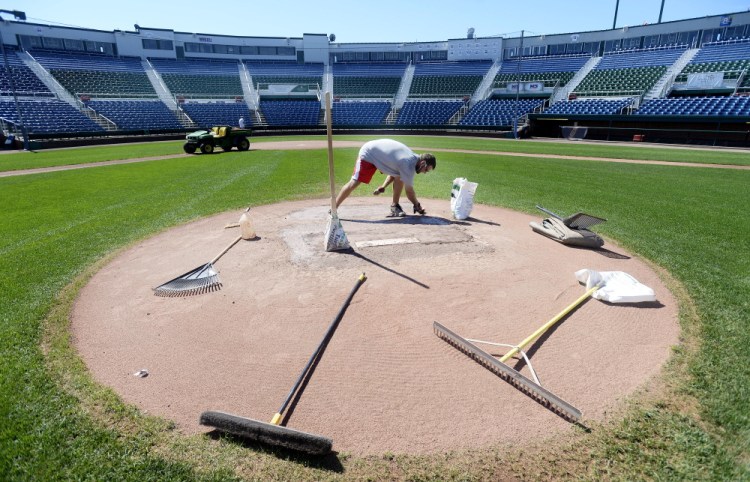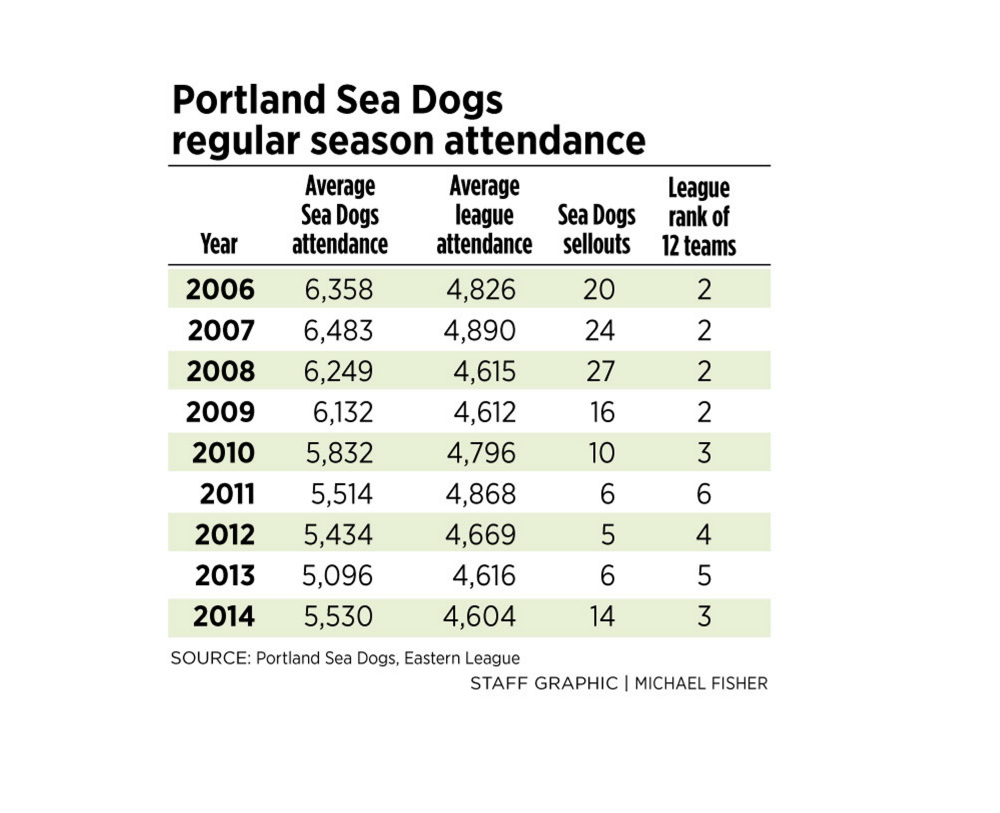Chris Kelley bought his playoff tickets shortly before noon Thursday. Three seats in section 203, middle of the row, a bit back so traffic on the walkway in front doesn’t obstruct his view for Game 3 of the Eastern League playoff series Friday night between the Sea Dogs and the Binghamton Mets at Hadlock Field.
After the Sea Dogs’ 7-0 victory Thursday, the series is now tied 1-1. Should the best-of-five series continue through Sunday, Kelley plans to return with his son for the clincher in the hopes of watching the Sea Dogs extend a standout season by winning a berth in the league championship series.
“We probably go to about 10 games a year,” said Kelley, 62. “We’ve been to a high of 25 and a low of about four over the years.”
The Portland resident is among the patrons who helped end a six-year slide in attendance for the Sea Dogs, whose franchise-best regular-season record (88-54) this season contributed to Hadlock being one of the most popular venues in the 12-team Eastern League.
Only Richmond (6,336) and Reading (5,801) averaged more fans for their games than the Sea Dogs (5,530) during the regular season.
The extra 434 fans per game represents an increase of 8.5 percent over last year.
“I’ll bet it’s because we had such a good team,” Kelley said of the Sea Dogs, who are back in the playoffs for the first time in six years.
In 2013, the Sea Dogs posted the worst attendance in the history of the franchise, dating to 1994.
“Last year was a challenging year for a number of reasons,” said Geoff Iacuessa, Sea Dogs general manager. “This year we were able to rebound a bit and go back in the direction we want to be going.”
This year’s Sea Dogs home schedule was kinder than in 2013, when the team had 31 Hadlock dates in April and May (plus two more on June 1-2). In early spring, the weather is typically colder and wetter and school is still in session. The Sea Dogs had 28 home dates this April and May.
Rain also played havoc with last year’s schedule and put a damper on walk-up sales. Team officials counted 74 times when the protective tarp was pulled over the infield last season, more than in any year since they started keeping track in 2009.
Until this season.
“We actually had one more tarp pull this year than last year,” Iacuessa said. “We also had back-to-back games (June 25 and July 4) that were sold out but were washed out.”
In other words, Portland’s 2014 attendance figures could have been even better. Still, the 14 sellouts were more than the previous two years combined (six and five) and climbed back into double figures for the first time since 2010.
“We’re thrilled with it,” Iacuessa said. “There’s a lot of external factors that we can’t control. But as for the internal factors, the staff did an unbelievable job this year and that’s what I’m most thrilled about. We had some new staff and they combined with veteran people to bring a lot of energy and experience. We made far more of an effort of going out and asking people to come to a game, and those efforts paid off.”
The Eastern League’s overall attendance dropped slightly for the third year in a row, although attendance throughout the affiliated minor leagues is up a bit, in large part because of new ballparks in North Carolina (Charlotte) and Texas (El Paso).
“The trend of the past decade,” said number cruncher David Kronheim, who compiles a yearly attendance analysis for both minor and major league baseball, “could be summed up in one word: flat.”
Kronheim works out of Flushing, New York, and publishes his reports on numbertamer.com. He said the 176 affiliated minor league teams in 15 leagues (he includes the Mexican League) reached the 41 million mark in 2005 and have remained slightly above that every year except 2007, when attendance rose to 42.8 million.
Official numbers are still coming in, but he said this year’s total will be roughly 42 million.
“This is going to be their third-highest ever,” he said. “It was a good year.”
Kronheim is often asked whether success on the field translates to success at the box office.
“Winning, I’d say, never hurts, but it’s generally not that big of a factor,” he said. “The fans realize that the teams have no control over who their players are.”
Kelley, the Sea Dogs fan, does pine for the seasons of Portland past when the parent club Florida Marlins usually left their Double-A roster intact throughout the year. The Red Sox, by contrast, tend to promote top prospects. This year Boston sent Mookie Betts, Blake Swihart and Henry Owens to Triple-A Pawtucket before they experienced a full season in Portland.
“I only saw Mookie Betts play twice this year,” Kelley said. “That’s not to say the guys (promoted) from Salem haven’t done a good job, but when the Marlins were here, I got to know them so well that you could predict who was coming in from the bullpen.”
He sighed.
“I know,” he said. “It’s all about development.”
The Sea Dogs haven’t hosted a playoff game since 2008. Their biggest playoff draw was Game 3 of the 2006 league championship series (7,195) with Akron after they had opened a 2-0 series lead in Ohio. Akron won Friday and Saturday night (6,187) in Portland before falling at Hadlock on Sunday afternoon before a crowd of 3,937.
Binghamton, which averaged a league-low 2,676 this season, attracted only 1,635 for Wednesday night’s series opener. As of Thursday afternoon, the Sea Dogs already had surpassed 3,500 tickets for Friday night and 2,200 for both Saturday and Sunday.
“For playoffs, it’s a difficult time of year, with school back in session,” Iacuessa said. “It’s not something you have a whole lot of time to market and get out there, but we do the best we can.”
Send questions/comments to the editors.





Success. Please wait for the page to reload. If the page does not reload within 5 seconds, please refresh the page.
Enter your email and password to access comments.
Hi, to comment on stories you must . This profile is in addition to your subscription and website login.
Already have a commenting profile? .
Invalid username/password.
Please check your email to confirm and complete your registration.
Only subscribers are eligible to post comments. Please subscribe or login first for digital access. Here’s why.
Use the form below to reset your password. When you've submitted your account email, we will send an email with a reset code.